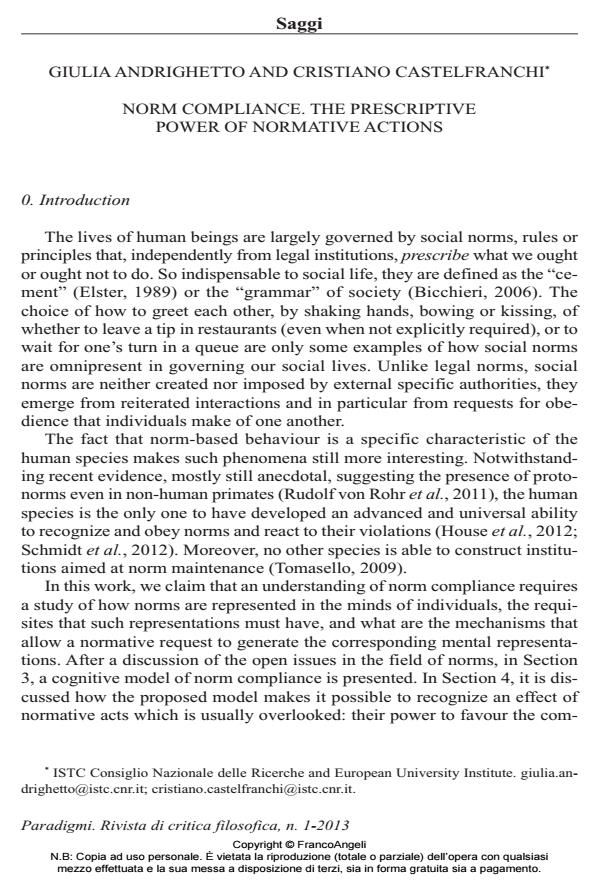Norm Compliance. The Prescriptive Power of Normative Actions
Titolo Rivista PARADIGMI
Autori/Curatori Giulia Andrighetto, Cristiano Castelfranchi
Anno di pubblicazione 2013 Fascicolo 2013/2 Lingua Italiano
Numero pagine 12 P. 139-150 Dimensione file 106 KB
DOI 10.3280/PARA2013-002011
Il DOI è il codice a barre della proprietà intellettuale: per saperne di più
clicca qui
Qui sotto puoi vedere in anteprima la prima pagina di questo articolo.
Se questo articolo ti interessa, lo puoi acquistare (e scaricare in formato pdf) seguendo le facili indicazioni per acquistare il download credit. Acquista Download Credits per scaricare questo Articolo in formato PDF

FrancoAngeli è membro della Publishers International Linking Association, Inc (PILA)associazione indipendente e non profit per facilitare (attraverso i servizi tecnologici implementati da CrossRef.org) l’accesso degli studiosi ai contenuti digitali nelle pubblicazioni professionali e scientifiche
Per comprendere il legame tra norme sociali e azione, proponiamo un’analisi del modo in cui le norme sono rappresentate nella mente degli individui e dei meccanismi che permettono la formazione delle rappresentazioni normative. Tale modello cognitivo dell’obbedienza alle norme permette anche di riconoscere una proprietà delle azioni normative solitamente ignorata: il loro potere di favorire la comunicazione e la conseguente diffusione di richieste normative.;
Keywords:Aspettative, comunicazione comportamentale implicita, influenzamento normativo, modellazione cognitiva, norme, punizione
- Andrighetto G., Conte R. e Giardini F. (2010a). Le basi cognitive della contro-aggressione: vendetta, punizione e sanzione. Sistemi Intelligenti, 3: 521-532.
- Andrighetto G., Villatoro D. and Conte R. (2010b). Norm Internalization in Artificial Societies. AI Communication, 23 (4): 325-339.
- Andrighetto G., Cecconi F., Conte R. e Villatoro D. (2011a). Simulazione ad Agenti e Teoria della Cooperazione. Il Ruolo della Sanzione. Sistemi intelligenti, 2: 367-376.
- Andrighetto G. and Villatoro D. (2011b). Beyond the Carrot and Stick Approach to Enforcement: An Agent-Based Model. In: Kokinov B., Karmiloff-Smith A., Nersessian N.J. (eds.). European Perspectives on Cognitive Science. Proceedings of the European Conference on Cognitive Science 2011. Sofia: New Bulgarian University Press.
- Becker G. (1968). Crime and Punishment: An Economic Approach. The Journal of Political Economy, 76: 169–217, DOI: 10.1086/25939
- Bicchieri C. (2006). The Grammar of Society. The Nature and Dynamics of Social Norms. Cambridge MA: Cambridge University Press.
- Bicchieri C. (2010). Norms, Preferences, and Conditional Behavior. Politics, Philosophy and Economics. 9 (3): 297-313, DOI: 10.1177/1470594X1036927
- Castelfranchi C., Pezzulo G. and Tummolini L. (2010). Behavioral Implicit Communication (BIC): Communicating with Smart Environments via our Practical Behavior and Its Traces. International Journal of Ambient Computing and Intelligence, 2 (1): 1-12, DOI: 10.4018/jaci.201001010
- Cialdini R.B., Reno R.R. and Kallgren C.A. (1990). A focus theory of normative conduct: Recycling the concept of norms to reduce littering in public places. Journal of Personality and Social Psychology, 58: 1015-1026, DOI: 10.1037/0022-3514.58.6.101
- Coleman J. (1990). Foundations of Social Theory. Cambridge (MA): Belknap.
- Conte R. (1998). L’obbedienza intelligente. Roma-Bari: Laterza.
- Conte R. and Castelfranchi C. (1995). Cognitive and social action. London: UCL Press.
- Conte R. and Castelfranchi C. (2006). The Mental Path of Norms. Ratio Juris, 19(4): 501-517, DOI: 10.1111/j.1467-9337.2006.00342.
- Conte R., Andrighetto G. and Campenni_ M., eds. (in press). Minding Norms. Mechanisms and Dynamics of Social Order in Agent Societies. New York: Oxford University Press.
- Diamond A.S. (1935). Primitive Law. London: Watts.
- Diekmann A. and Przepiorka W. (2010). Signaling and Social Norms: Theory, Model, and Empirical Evidence. Working Paper, ETH Zurich Sociology.
- Elster J. (1989). The Cement of Society. Cambridge: Cambridge University Press, DOI: 10.1017/CBO978051162499
- Fehr E. and Fischbacher U. (2004a). Social Norms and Human Cooperation. Trends in Cognitive Sciences. 8(4): 185-190, DOI: 10.1016/j.tics.2004.02.007FehrE.andFischbacherU.(2004b).Third-partyPunishmentandSocialNorms.EvolutionandHumanBehavior,25(2):63-87,doi:10.1016/S1090-5138(04)00005-
- Hardin, G. (1968). The Tragedy of the Commons. Science, 162: 1243-1248, DOI: 10.1126/science.162.3859.124
- House B., Henrich J., Brosnan S. and Silk J. (2012). The Ontogeny of Human Prosociality: Behavioral Experiments with Children aged 3 to 8. Evolution and Human Behavior, 33: 291-308, DOI: 10.1016/j.evolhumbehav.2011.10.00
- Houser D. and Xiao E. (2010). Understanding Context Effects. Journal of Economic Behavior and Organization, 73(1): 58-61, DOI: 10.1016/j.jebo.2008.01.00
- Leonardi P. (1983). Sulle regole. Verona: Libreria Universitaria Editrice.
- Miceli M. and Castelfranchi C. (2002). The Mind and the Future: the (negative) Power of Expectations. Theory and Psychology. 12: 335-366, DOI: 10.1177/095935430201200301
- Miller G., Galanter E. and Pribram K. (1960). Plans and the Structure of Behaviour. New York: Henry Holt, DOI: 10.1037/10039-00
- Ross A. (1968). Directives and Norms. London: Routledge.
- Rudolf von Rohr C., Burkart J. and van Schaik C. (2011). Evolutionary Precursors of Social Norms in Chimpanzees: A new approach. Biology and Philosophy, 26: 1-30, DOI: 10.1007/s10539-010-9240-
- Schmidt M., Rakoczy H. and Tomasello M. (2012). Young Children Enforce Social Norms Selectively Depending on the Violator’s Group Affiliation. Cognition, 124 (3): 325–333, DOI: 10.1016/j.cognition.2012.06.00
- Sripada C. and Stich S. (2006). A Framework for the Psychology of Norms. In: Carruthers P., Laurence S. and Stich S., eds. The Innate Mind: Culture and Cognition . Oxford: Oxford University Press: 280-301.
- Sugden R. (2004). The Economics of Rights, Co-operation and Welfare. New York: Palgrave Macmillan, 2nd ed., DOI: 10.1057/978023053679
- Tomasello M. (2009). Why we cooperate. Cambridge: MIT Press (MA).
- Can Lawlike Rules Emerge without the Intervention of Legislators? Klaus G. Troitzsch, in Frontiers in Sociology 2/2018
DOI: 10.3389/fsoc.2018.00002 - Advances in Social Simulation 2015 Klaus G. Troitzsch, pp.413 (ISBN:978-3-319-47252-2)
Giulia Andrighetto, Cristiano Castelfranchi, Norm Compliance. The Prescriptive Power of Normative Actions in "PARADIGMI" 2/2013, pp 139-150, DOI: 10.3280/PARA2013-002011